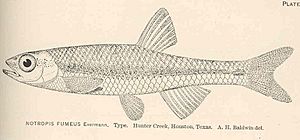Ribbon shiner facts for kids
Quick facts for kids Ribbon shiner |
|
|---|---|
 |
|
| Conservation status | |
| Scientific classification | |
| Synonyms | |
|
The ribbon shiner (Lythrurus fumeus) is a small freshwater fish. It belongs to the cyprinid family, which includes minnows and carps. This fish is naturally found in the United States.
Contents
About the Ribbon Shiner
The ribbon shiner is a type of cyprinid fish. It has a short, rounded snout and a fairly large mouth at the end of its head. Its head is short, but its eyes are big, even bigger than its snout!
The body of the ribbon shiner is somewhat deep and long. It is also flattened from side to side. Unlike some other fish, its top fin (dorsal fin) does not have a clear black spot.
The top of the fish is usually an olive or straw color with a shiny silver look. It also has a dark stripe along its back. The underside of the fish is silvery white, with a silver-black stripe along its side. Ribbon shiners have small scales, with more than 21 rows of scales before the dorsal fin. They also have 10 to 12 rays in their anal fin. The longest ribbon shiner ever found was about 55 millimeters (2.16 inches) long.
What Ribbon Shiners Eat
Ribbon shiners often swim together in groups, called schools. They usually stay in the middle or near the surface of the water.
During the wet season, about 64% of their food comes from the water's surface. Another 34% comes from animals that live at the bottom, called benthic animals.
In the dry season, when food might be harder to find, about 37% of their diet still comes from the surface. Between 8% and 21% of their food comes from the middle of the water or from the bottom.
Where Ribbon Shiners Live
Ribbon shiners like to live in calm streams. These streams can be small to medium in size. The water might be clear or a bit cloudy. The bottom of these streams can be made of different things like sand, mud, clay, silt, or dead plant material.
Reproduction and Life Cycle
Ribbon shiners lay their eggs during the late spring or summer months. When it's time to breed, male ribbon shiners turn yellow. Interestingly, male and female adult ribbon shiners are about the same size.
They are "broadcast spawners," which means they release their eggs and sperm into the water. The eggs are then fertilized outside the body. Scientists do not yet know how old ribbon shiners are when they become old enough to reproduce.
Where to Find Ribbon Shiners
The ribbon shiner lives in several places across the United States. You can find them in rivers and streams that flow into the Gulf of Mexico. This includes areas from Lake Pontchartrain in Louisiana to the Navidad River in Texas. They are in all river systems connected to Lake Pontchartrain, except for the Tangipahoa River.
They also live in the Mississippi River Basin. This area stretches from the lower Mississippi River to the Tennessee River. You can find them in parts of central Illinois, southwestern Indiana, eastern Oklahoma, western Kentucky, and northwestern Alabama. Most ribbon shiners live below a geological feature called the Fall Line, but some are found above it in the Arkansas River drainage.
Name Meaning
The scientific name for the ribbon shiner is Lythrurus fumeus. This name has a cool meaning!
- Lythrurus comes from two Greek words: lythron (meaning "blood") and oura (meaning "tail"). So, Lythrurus means "blood tail" or "red tail."
- Fumeus is a Latin word that means "smoky."
So, Lythrurus fumeus together means "smoky red tail."
See also
 In Spanish: Lythrurus fumeus para niños
In Spanish: Lythrurus fumeus para niños


